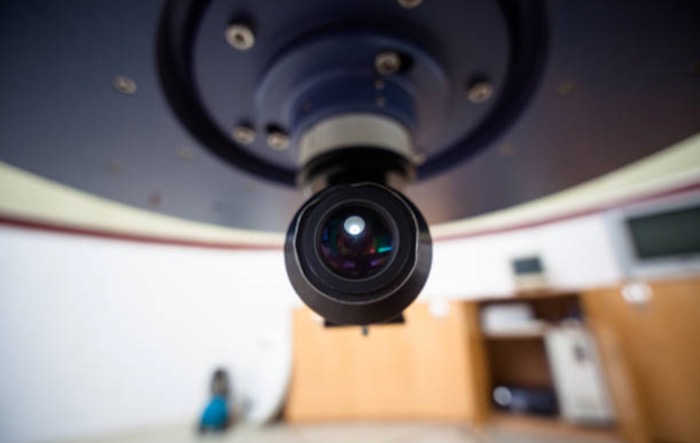How to make video communication comfortable enough for participants to perceive it as live?
This effect can be achieved if the camera captures not only the general plan of the room, but also a specific participant.
Transitions between scenes should be fast and smooth so that communication does not cause discomfort and does not distract participants from discussing work issues. How to achieve this?
PTZ camera for live streaming can help you. On this article we’ll talk about the things you need about this type of cameras.
What is a PTZ Camera?
PTZ is an abbreviation of three words: pan, tilt and zoom. They characterize the main functions of PTZ cameras.
Panning means that the camera lens can move horizontally (360°). Tilt is the ability of the camera to move up and down (usually -15° to +90°). Zooming allows the lens to zoom in and out of the desired object (magnification can reach 30 times or more).
In a sense, a PTZ tracking camera can be viewed as a robot that is able to change direction and view angle on its own or through a remote control option.
Types of PTZ Сameras
Most PTZ cameras differ in zoom and video output. SDI, HDMI, IP streaming, NDI and USB are prominent video outputs. Let’s explore each video output’s usage.
SDI is the most used PTZ camera video output owing to its durability, dependability, and extended range. Its locking connection secures a camera, video switch, or other equipment. It has a copper cable with BNC connections.
SDI lets cameras deliver video and audio to devices without network infrastructure. This plug-and-play cable is used in video production. With these connections, a PTZ 4k camera may attain resolutions up to 4K.
Next is HDMI. It’s popular because it works with most consumer electronics. HDMI is in most displays and video switchers. This cable supports 4K resolutions but can only go 15 meters without a signal loss, unlike SDI.
HDMI equipment is cheaper than SDI. Consumers and homeowners often employ HDMI video switchers and systems. Despite the fact that the HDMI method is less expensive, it restricts the length of wires you may use to connect your camera to your computer.
Ethernet is another common PTZ camera wire. Ethernet can now do more than operate a camera. With a PoE network switch, a single Ethernet connection can charge your PTZ camera while also providing low latency IP video and control.
Some SDI PTZ cameras include built-in PoE connection, and Ethernet replaces power supply and plugs in distant locations. This cable is the most innovative as IP video and Ethernet technologies progress. PTZ cameras now support the NDI video protocol.
A PTZ webcam usb can link to video streaming or production applications like a laptop webcam. UVC may also be controlled through USB. USB connections may not have enough bandwidth to handle HD video from PTZ webcams. Most PCs can only handle 1-2 USB HD cameras. USB cables may be expanded. It’s only employed when a limited number of close-by cameras are needed.
Requirements for the Network
A high-quality stream requires a dependable network with HD video capacity. It takes a lot of bandwidth to stream clear audio and video. Ensure your routers and network switches are up-to-date. For a solid network, we suggest 1G.
High-quality live broadcast means 1080p @ 30Hz. Your viewers will notice a reduced resolution and can tune out.
Streaming Protocols
Streaming protocols provide data over the web when you view YouTube or Twitch. RTMP is a classic low-latency streaming technology.
RTMP is Adobe’s open-source Real Time Messaging Protocol. It’s standard on YouTube, Twitch, and Periscope. You’ll need an RTMP-compatible camera to livestream on these media servers.
Facebook utilizes RTMPS from May 2019. Facebook introduced the “S” security layer. It protects users by securing video material. Consequently, in order to broadcast live on Facebook, you will need to install a firmware upgrade if your camera is older than May 2019.
Resolution and Zoom
Knowing your audience’s expectations is crucial. Determine your camera’s objectives, such as resolution. Keep in mind that the camera’s mounting distance affects FOV and zoom especially in an outdoor PTZ camera. PTZ cameras may zoom 10x, 12x, 20x, or 30x for optimal FOV. Do long-range signal broadcasts need an extender? These criteria matter while choosing a PTZ camera.
Control
IR, WebGUI, and joystick control PTZ cameras. Most cameras come with an IR remote for basic control. You may pan, rotate, zoom, and change audio on the linked preview screen. Not the best control tool, but it works.
Also, use WebGUI. PTZ cameras have a preset IP address for web browsers. The WebGUI can adjust resolutions, IP addresses, and settings like the IR remote.
Joystick controllers are precise. A short-range RS-232 joystick controller may be utilized. IP joystick controllers communicate through RS-232 and LAN for long-range applications. An IP joystick controller adds flexibility, distance, and accuracy by allowing you to search for and operate specific cameras.
Networked cameras may be controlled. Your live stream configuration may need a camera video switch, which adds protocol layers. Add audio mixers to your network’s protocols.
PTZ cameras are amazing pieces of technology and they continue to evolve rapidly. PTZ cameras with 4K resolution are already commercially available. The next generation of PTZ cameras will be even more powerful.


